
The standard circulating coinage of the United Kingdom, British Crown Dependencies and British Overseas Territories is denominated in pennies and pounds sterling, and ranges in value from one penny sterling to two pounds. Since decimalisation, on 15 February 1971, the pound has been divided into 100 pence. Before decimalisation, twelve pence made a shilling, and twenty shillings made a pound.

The shilling is a historical coin, and the name of a unit of modern currencies formerly used in the United Kingdom, Australia, New Zealand, other British Commonwealth countries and Ireland, where they were generally equivalent to 12 pence or one-twentieth of a pound before being phased out during the 1960s and 1970s.

A penny is a coin or a unit of currency in various countries. Borrowed from the Carolingian denarius, it is usually the smallest denomination within a currency system. At present, it is the formal name of the British penny (abbr. p) and the de facto name of the American one-cent coin (abbr. ¢) as well as the informal Irish designation of the 1 euro cent coin (abbr. c). Due to inflation, pennies have lost virtually all their purchasing power and are often viewed as an expensive burden to merchants, banks, government mints and the public in general.

The history of the English penny from 1603 to 1707 covers the period of the House of Stuart, up to the Acts of Union of 1707 which brought about the Union of the Kingdom of England with the Kingdom of Scotland.

Sterling is the currency of the United Kingdom and nine of its associated territories. The pound is the main unit of sterling, and the word pound is also used to refer to the British currency generally, often qualified in international contexts as the British pound or the pound sterling.
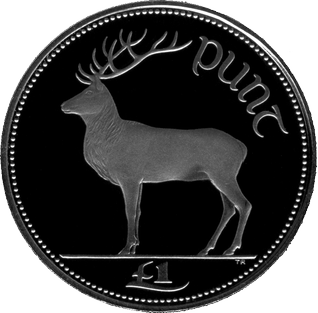
The pound was the currency of Ireland until 2002. Its ISO 4217 code was IEP, and the symbol was £ The Irish pound was replaced by the euro on 1 January 1999. Euro currency did not begin circulation until the beginning of 2002.

The groat is the traditional name of a defunct English and Irish silver coin worth four pence, and also a Scottish coin which was originally worth fourpence, with later issues being valued at eightpence and one shilling.
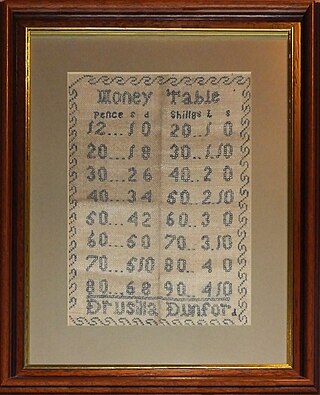
£sd, spoken as "pounds, shillings and pence", is the popular name for the pre-decimal currencies once common throughout Europe. The abbreviation originates from the Latin currency denominations librae, solidi, and denarii. In the United Kingdom, these were referred to as pounds, shillings, and pence.
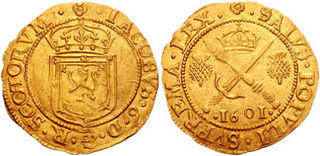
The pound was the currency of Scotland prior to the 1707 Treaty of Union between the Kingdom of Scotland and the Kingdom of England, which created the Kingdom of Great Britain. It was introduced by David I, in the 12th century, on the Carolingian monetary system of a pound divided into 20 shillings, each of 12 pence. The Scottish currency was later devalued relative to sterling by debasement of its coinage. By the time of James III, one pound Scots was valued at five shillings sterling.
The pound is the currency of Guernsey. Since 1921, Guernsey has been in currency union with the United Kingdom and the Guernsey pound is not a separate currency but is a local issue of sterling banknotes and coins, in a similar way to the banknotes issued in Scotland, England and Northern Ireland. It can be exchanged at par with other sterling coinage and notes.

The merk is a long-obsolete Scottish silver coin. Originally the same word as a money mark of silver, the merk was in circulation at the end of the 16th century and in the 17th century. It was originally valued at 13 shillings 4 pence, later raised to 14s. Scots.
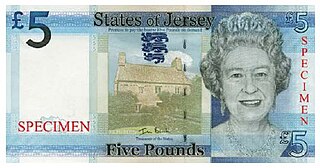
The pound is the currency of Jersey. Jersey is in currency union with the United Kingdom, and the Jersey pound is not a separate currency but is an issue of banknotes and coins by the States of Jersey denominated in sterling, in a similar way to the banknotes issued in Scotland and Northern Ireland. It can be exchanged at par with other sterling coinage and notes.
The pound, or Manx pound, is the currency of the Isle of Man, at parity with sterling. The Manx pound is divided into 100 pence. Notes and coins, denominated in pounds and pence, are issued by the Isle of Man Government.
A markland or merkland is an old Scottish unit of land measurement.
From c. 1124 until 1709 the coinage of Scotland was unique, and minted locally. A wide variety of coins, such as the plack, bodle, bawbee, dollar and ryal were produced over that time. For trading purposes coins of Northumbria and various other places had been used before that time; and since 1709 those of the Kingdom of Great Britain, and then of the UK.
Irish coins have been issued by a variety of local and national authorities, the ancient provincial Kings and High Kings of Ireland, the Kingdom of Ireland (1541–1801), the United Kingdom of Great Britain and Ireland (1801–1922), the Irish Free State (1922–1937), and the present Republic of Ireland. Since 2002, the Republic of Ireland has minted Euro coins, featuring symbols such as flax and the harp.

A bawbee was a Scottish sixpence. The word means a debased copper coin, valued at six pence Scots, issued from the reign of James V of Scotland to the reign of William II of Scotland. They were hammered until 1677, when they were produced upon screw presses.
A plack was an ancient Scottish coin of the value of four Scots pence or, by 1707, one-third of an English penny.
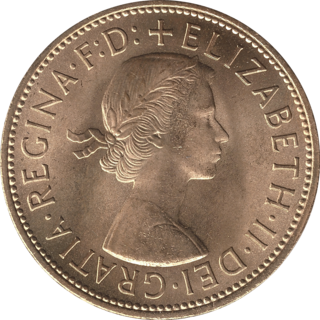
The British pre-decimal penny was a denomination of sterling coinage worth 1⁄240 of one pound or 1⁄12 of one shilling. Its symbol was d, from the Roman denarius. It was a continuation of the earlier English penny, and in Scotland it had the same monetary value as one pre-1707 Scottish shilling. The penny was originally minted in silver, but from the late 18th century it was minted in copper, and then after 1860 in bronze.
The English shilling was a silver coin of the Kingdom of England, when first introduced known as the testoon. A shilling was worth twelve pence, and there were 20 shillings to the pound sterling. The English shilling was introduced in the 16th century and remained in circulation until it became the British shilling as the result of the Union of England and Scotland to form the Kingdom of Great Britain in 1707.














